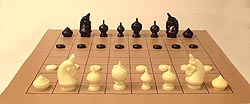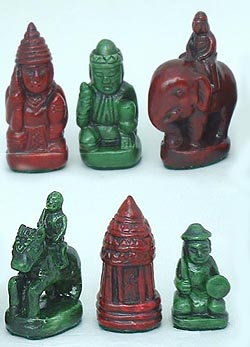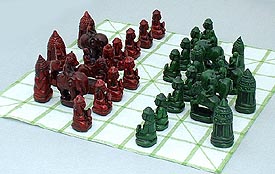| |
|
An Illustrated History of Chess_________________3____
|
Compare
these pieces to the ones we were just examining. The board is
the same, and you can still recognize the horse...but the other
pieces have been replaced by neatly lathed abstractions.
Throughout the history of chess, this desire to make lathed pieces
has been at work, changing the shape of chessmen.  The pieces here are so similar to each other that you might at
first have trouble telling them apart.
The pieces here are so similar to each other that you might at
first have trouble telling them apart. |
| This
is makruk, the national chess of Thailand,
still played avidly throughout that country. All pieces, except
one, retain the same moves they had in ancient chess, but the former
chariot is considered to be a boat, the elephant
is now a nobleman, the king's assistant is a seed
and the foot soldier is a cowry shell. An interesting
mix of changes that fits the local realities of transportation and
politics, and the shapes and materials of the playing pieces. |

makruk, ready for a first move |

move of the nobleman, the typical "elephant's"
move
in Southeast Asia |
Note
also that the pawns are placed on the third row, something this
form of chess shares with Japanese chess — as we shall see
later.
The one piece that moves differently from its ancient counterpart
is the elephant/nobleman. Here we have an interesting story:
It is said that the elephant's move which caught on in Southeast
Asia represented the "five appendages" of the elephant.
He moved to the four diagonal directions for each of his legs,
plus straight forward — for the trunk.
The Thai "elephant" retains this centuries old interpretation,
but the specific image of the move is lost, as the piece has now
become a nobleman.
|
In Burmese
chess, sittuyin, that piece moving in those five directions
still is an elephant. And you can be sure because the
centuries-old figures of chessmen is Burma are literal representations
of their battlefield characters. Take a look at the pieces shown
here: they are sculpted interpretations of the armed warriors
well known from the ancient Persian, Indian and Islamic game.
Only the rook is a
little odd. The piece is called a chariot or carriage (in Burmese,
of course), but it is usually depicted as a small ceremonial hut.
 Strangely similar to our modern rook shaped like a castle turret,
here again we have a stationary building running around on the
battlefield.
Strangely similar to our modern rook shaped like a castle turret,
here again we have a stationary building running around on the
battlefield. |

typical
Burmese style sittuyin chessmen
|

the
Burmese chessmen set up:
pawns advanced to the 3rd and 4th rank and
pieces strataegically laid out by the players
before play begins
|
But the Burmese game
certainly has a twist of its own —
one of the biggest changes in the history
of the game. For starters, the Burmese pawns are set up far advanced,
some on the 3rd and some on the 4th rows. So far forward that the
first move of the game could be one pawn capturing another.
But the big twist is that once the pawns are set up, the players
place their pieces wherever they like behind the pawn rows (some
restrictions apply). It is as if the whole opening series of moves
is done at once and play commences in the middle of the game. |
So, we've seen that the ancient Persian chess moved westward,
where it became the Arabian game, and eventually evolved into
our modern western "international" chess. And it moved
east and south, where it became the Burmese sittuyin
and the Thai game of makruk...but
wait!
There
is another lineage of chess which may pre-date these
games altogether!
Let's take a look at chess in China...
<<Previous
Page ... Next Page>>
|
__
|
|





